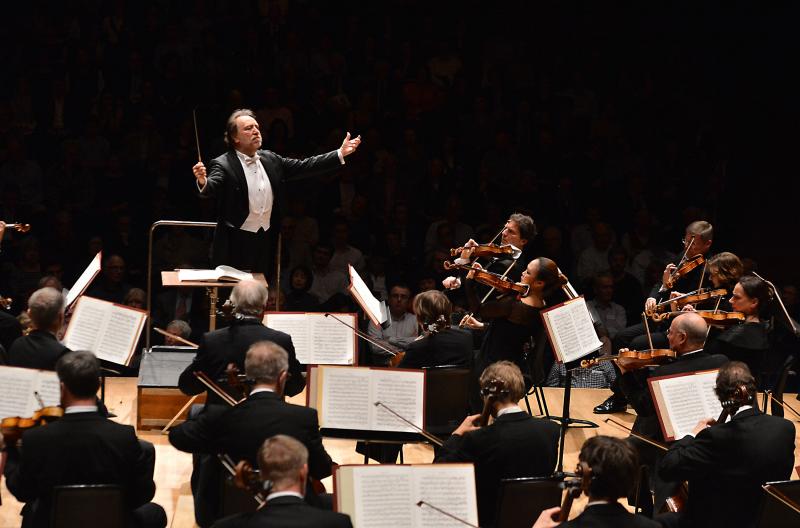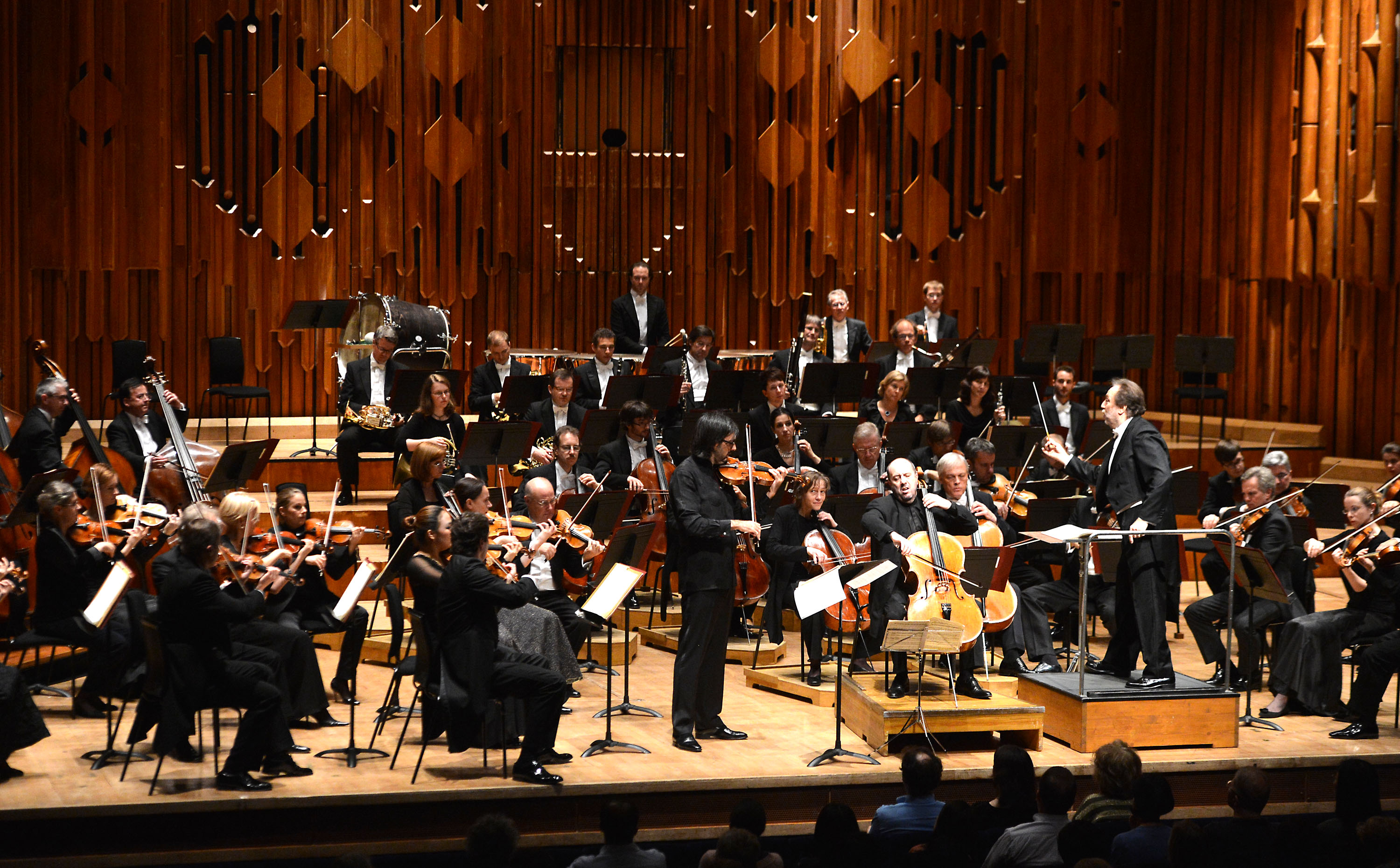Brahms Cycle 1: Kavakos, Dindo, Leipzig Gewandhaus Orchestra, Chailly, Barbican | reviews, news & interviews
Brahms Cycle 1: Kavakos, Dindo, Leipzig Gewandhaus Orchestra, Chailly, Barbican
Brahms Cycle 1: Kavakos, Dindo, Leipzig Gewandhaus Orchestra, Chailly, Barbican
Rebellious Brahms from the team which knows him best

For the Leipzig Gewandhaus Orchestra’s second residency at the Barbican Centre Riccardo Chailly pulled focus on an entirely new sounding Brahms. Gone were all those bad performance practices, bad habits, from the early 20th century, gone was the lingering romanticism, the willful soupiness, and in with a vengeance came a classical rigour, a lean and hungry vitality.
Chailly is neatly lining up the four symphonies with the four concertos - and first up were Leonidas Kavakos and Enrico Dindo (pictured with Chailly and the orchestra below) in the Double Concerto. The opening statement from the orchestra was a throwing down of the gauntlet if ever I heard one: emphatic, arresting, cut to the bone. Cellist Enrico Dindo then soliloquised in Shakesperian fashion, a whole range of colours suggesting a whole range of emotions, all within a couple of minutes. Kavakos’ violin parried but the drama, gruff and gritty as it was, was in the conversation, now conciliatory, now confrontational. The telepathy, chemistry, call it what you will, between Kavakos and Dindo was self-evident and challenging and even that prayerful slow movement tune refused to linger. Mellow it was not.

And so to the first of the symphonies - 14 years in the making - sounding like it was determined to make up for lost time. That lowering opening coming up through the bass lines, timpani carving a path through the mire, violins reaching for light, was as arresting as it’s ever been, an imperative alla breve. That was to be Chailly’s defining way throughout the piece with the allegro of this opening movement determined to shake off disillusionment. It smouldered.
The deep and abiding consolation of the slow movement with the deep echo of string basses beautifully realised brought gorgeous singing oboe playing and radiant work from the Leipzig concert master. How different this movement sounded with a century of soupy sentiment stripped away.
The finale had a surprise or two up its sleeve, the desolate pizzicato of the opening paragraph falling like rain from the gathering clouds. I’ve never heard it in quite the same way before. And how good to hear the burnished horn solo and ensuing chorale freed of portentousness. Chailly managed the switch from the big “ode to joy” theme into Brahms’ impulsive allegro with a exhilarating upping of the tempo and when he and Brahms finally broke free in the coda the momentary disbelief at the reckless abandon of the tempo thrillingly demonstrated jut how conditioned we had become. Bring on the rest.
rating
Explore topics
Share this article
The future of Arts Journalism
You can stop theartsdesk.com closing!
We urgently need financing to survive. Our fundraising drive has thus far raised £33,000 but we need to reach £100,000 or we will be forced to close. Please contribute here: https://gofund.me/c3f6033d
And if you can forward this information to anyone who might assist, we’d be grateful.

Subscribe to theartsdesk.com
Thank you for continuing to read our work on theartsdesk.com. For unlimited access to every article in its entirety, including our archive of more than 15,000 pieces, we're asking for £5 per month or £40 per year. We feel it's a very good deal, and hope you do too.
To take a subscription now simply click here.
And if you're looking for that extra gift for a friend or family member, why not treat them to a theartsdesk.com gift subscription?
more Classical music
 Davis, National Symphony Orchestra, Maloney, National Concert Hall, Dublin review - operetta in excelsis
World-class soprano provides the wow factor in fascinating mostly-Viennese programme
Davis, National Symphony Orchestra, Maloney, National Concert Hall, Dublin review - operetta in excelsis
World-class soprano provides the wow factor in fascinating mostly-Viennese programme
 Best of 2024: Classical music concerts
Young and old in excelsis, and competition finales turned into winning programmes
Best of 2024: Classical music concerts
Young and old in excelsis, and competition finales turned into winning programmes
 Spence, Perez, Richardson, Wigmore Hall review - a Shakespearean journey in song
A festive cabaret - and a tenor masterclass
Spence, Perez, Richardson, Wigmore Hall review - a Shakespearean journey in song
A festive cabaret - and a tenor masterclass
 Best of 2024: Classical CDs
Our pick of the year's best classical releases
Best of 2024: Classical CDs
Our pick of the year's best classical releases
 First Person: cellist Matthew Barley on composing and recording his 'Light Stories'
Conceived a year ago, a short but intense musical journey
First Person: cellist Matthew Barley on composing and recording his 'Light Stories'
Conceived a year ago, a short but intense musical journey
 The English Concert, Bicket, Wigmore Hall review - a Baroque banquet for Christmas
Charpentier's charm, as well as Bach's bounty, adorn the festive table
The English Concert, Bicket, Wigmore Hall review - a Baroque banquet for Christmas
Charpentier's charm, as well as Bach's bounty, adorn the festive table
 Classical CDs: Woden, waltzes and watchmaking
Big box sets, a great British symphony and a pair of solo cello discs
Classical CDs: Woden, waltzes and watchmaking
Big box sets, a great British symphony and a pair of solo cello discs
 Messiah, Wild Arts, Chichester Cathedral review - a dynamic battle between revelatory light and Stygian gloom
This supple inventive interpretation of the 'Messiah' thrillingly delivers the story
Messiah, Wild Arts, Chichester Cathedral review - a dynamic battle between revelatory light and Stygian gloom
This supple inventive interpretation of the 'Messiah' thrillingly delivers the story
 Christmas with Connaught Brass, Milton Court review - delightful seasonal fare from Bach to Boulanger
Young quintet dazzle with their technical accomplishment and easy charm
Christmas with Connaught Brass, Milton Court review - delightful seasonal fare from Bach to Boulanger
Young quintet dazzle with their technical accomplishment and easy charm
 Classical CDs: Christmas 2024
The year's best seasonal releases
Classical CDs: Christmas 2024
The year's best seasonal releases

Add comment